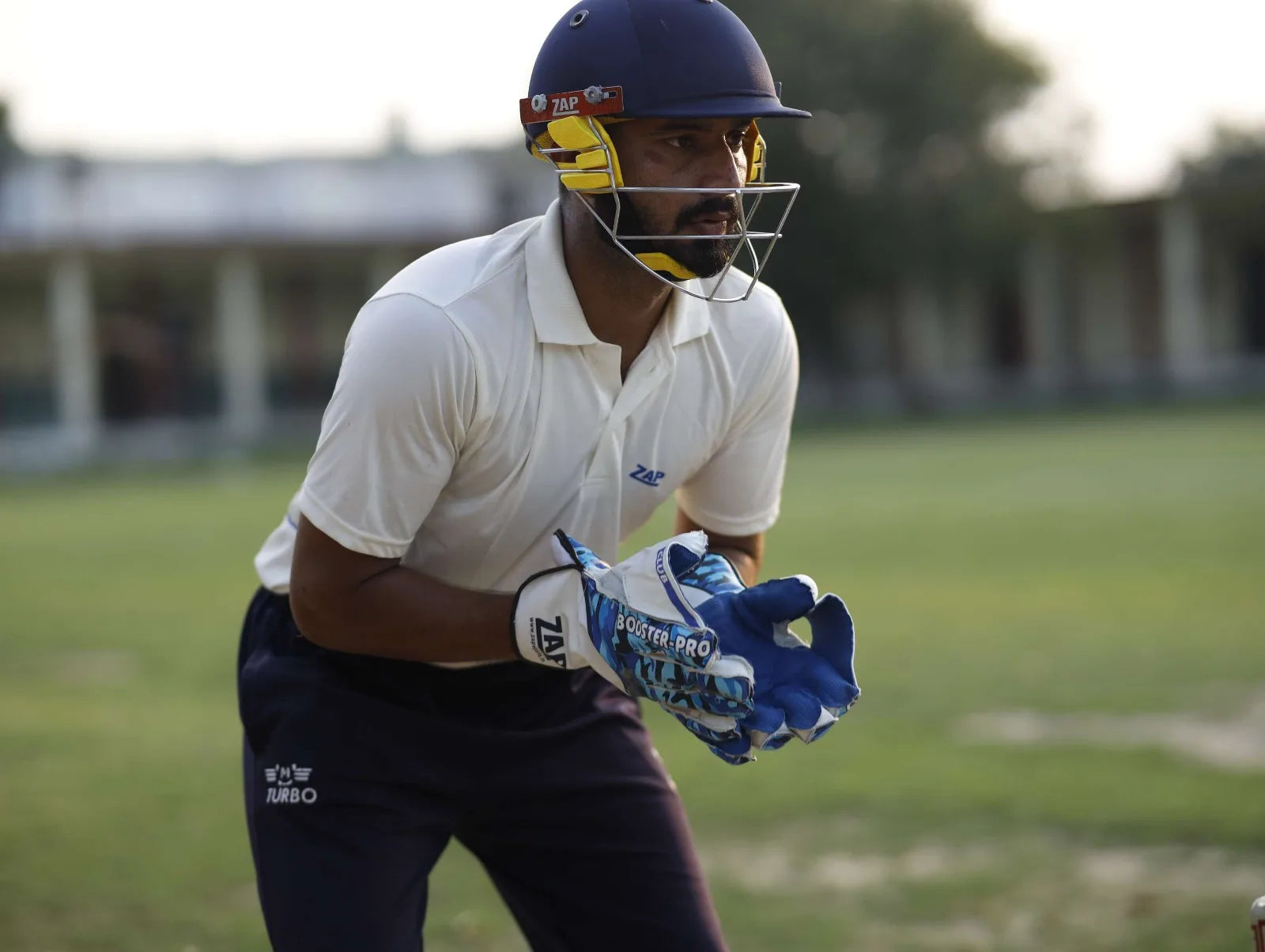Imagine squatting for hundreds of deliveries every day, standing behind the stumps, cheering for your team and being the team’s backbone. That’s the role of a wicket keeper, one of the most physically and mentally challenging jobs on the cricket ground. The keeper holds everything together, analyse the batsman’s footwork and help the captain make and change strategies, talk to the bowler and help them bowl the right line and lengths. On top of this he must do his own job with perfection: be vigilant for every ball of the innings, adjust to the pace and lengths of the bowlers, and stand erect while wearing a heavy kit in every situations.

In this chapter of learn with ZAP, let’s look at the right wicket keeping tips and technique in cricket to help you change the game from behind the stumps.
What does a wicket keeper do?
The wicketkeeper is not just a player behind the stumps; they are the team's ultimate line of defense. He is the central figure for a team’s performance. The keeper is a player on the fielding side who stands behind the stumps, keeps an eye on the batter and always prepared to take a catch, stump the batter, or run them out. Only the keeper is allowed to wear external leg guards and keeping gloves on the fielding side. But it goes beyond just catching those leather balls, they have a holistic understanding of the game, lightning-fast reflexes, and be strategic in positioning. Keepers are often considered the unsung heroes in a cricket match, as their contributions can make or break a match.

Qualities of a wicket keeper:
Reflexes
- Wicketkeepers require exceptional spatial awareness and hand-eye coordination.
- There is nothing more crucial to keeping than quick reactions, so honing these abilities, you will be able to respond quickly on the pitch.
- The basic drills will help your technique to grow, and as the fundamentals get stronger, so does positioning. Reflexes, however, are something that require regular practise.
Footwork
- Wicketkeepers need to have a good footwork in order to cover more ground behind the stumps.
- Keeping your feet moving will enable you to position yourself in a way that will allow you to dive for a ball if necessary or perform a catch manoeuvre if a ball has veered off course.
- When a spinner bowls on a turning pitches, footwork is particularly crucial because a keeper won't always be able to predict the spin of the ball.
- When you have to keep in longer formats, your footwork is extremely important. Everything goes out of balance with a proper footwork, including your positioning and glove technique.
Glove Technique:
- A wicketkeeper's proficiency with his or her hands and how they manage the ball once it enters their gloves determines how effective they are.
- Precise glove control prevents errors and in pressure moments, a keeper’s skill impacts matches significantly, contributing to the team's success.

On top of this, in the modern game like T20s and other shorter formats, a wicket keeper needs to have a very good cricket batting technique to help the team with the bat. And as usually the wicket keepers play in the middle or the lower middle order, they need to have the ability to finish matches well in the death over by power hitting the ball out of the park.
Wicket Keeping Technique:
The Stance:
The right stance is the foundation of a good technique. Stand about 3-5 steps behind the stumps for spinners and about as the same distance as the length of the bowler’s run up for pacers. Keep your feet a bit wide than the shoulder width and have knees slightly bent. Flexibility and strength in your thighs and hamstrings are key for squatting when you go down. Also, wear comfortable wicket keeping pads that help you in squatting and are not bulky restricting your movement.
Hand Positioning:
Position your hands in front of your body when setting up. Keep them light, and easy to move. Once the bowler bowls the ball, move your hands and your body in line with the delivery, ready to react to thick edge and catches.
Catching the ball:
When the ball comes close, drive your hand behind with it and grab them with your gloves. That’s the safest and the best ways. Keep your hand soft or the ball might bounce off of the gloves. The gloves matter a lot. Wear one with a high-quality leather material in the palms and good cushioning on the inside for enhanced comfort.

Tips to Improve your wicket keeping skills:
Have a clear understanding of your tasks in each game format and how you want to perform as a wicket keeper. Set your focus on each ball and keep an eye on it as it leaves the bowler's hand. Be present with each ball; you will make mistakes; just let them go; then, shift your attention to the next ball. Your footwork and glovework matter. Top keepers help the captain set the fielding positions accurately.
Wicket Keeping Basics: The Foundation of Success
You must be in a relaxed position, stable on your feet, and prepared to move in any direction. For rapid and precise catches, glove technique and hand alignment are essential. In order to anticipate the delivery, keep your hands relaxed with your fingers spread slightly apart.
Quick Reflexes: The Need for Speed
Keepers need to react to the ball's trajectory within milliseconds. and this requires exceptional hand-eye coordination and quick reflexes. Train to improve your reflexes with reaction training exercises.
Understanding Pitch Conditions
Different cricket pitches behave differently which influences the movement of the ball. A quality keeper understands how the pitch affects the trajectory and bounce of the ball. Just look at how MS Dhoni’s wicket keeping. The way he kept against spinner and pacers, how he read the pitch and adapted to it to become on of the best wicket keepers of all times.

Credit: Circle of Cricket
Footwork Mastery:
Wicket keepers are the most agile fielders on the ground. Being light on your feet allows you to move swiftly to gather wide throws, attempt stumpings, or make diving catches. Practice shuffling and sliding to improve your overall agility.
Communication with Bowlers:
Wicket keepers, bowlers and captains work very closely during a cricket match. As a keeper behind the stumps, your job is to have clear communication with the other two to devise strategies and execute plans effectively. Share your insights about the batsman’s weaknesses and help the bowlers get important breakthroughs.
Conclusion:
With constant and consistent hard work and determination, you can master the wicket keeping skill in cricket and take your team's performance a notch up.



Share:
Understanding Cricket Bowling Actions: The Ultimate Guide
Sydney Cricket Ground: A Historic Sporting Venue
1 comment
Make me a professional wicketkeeper